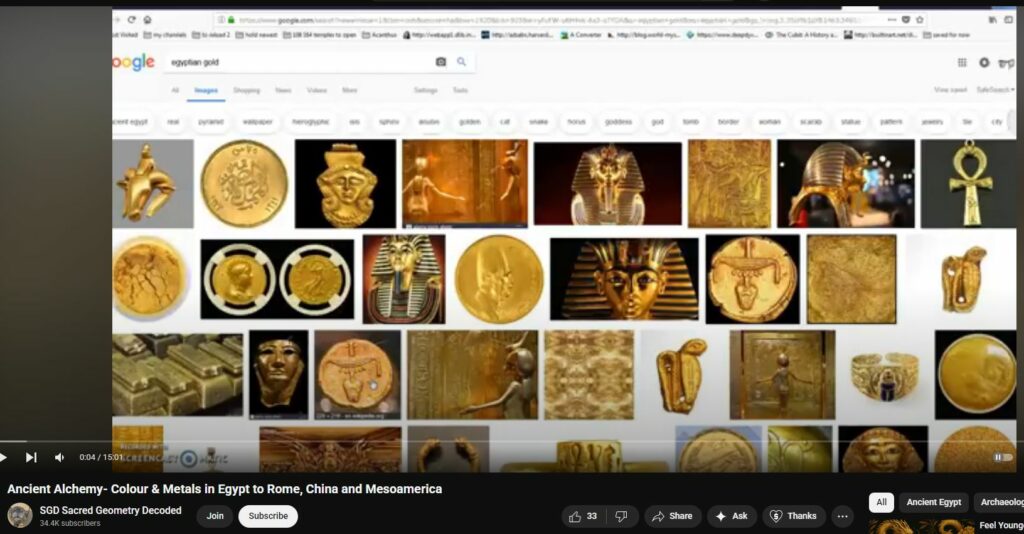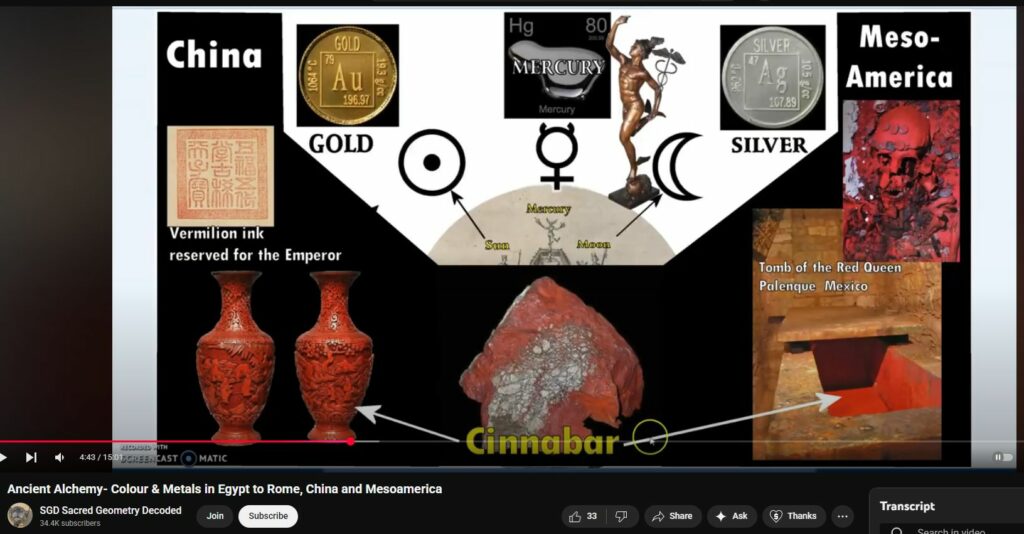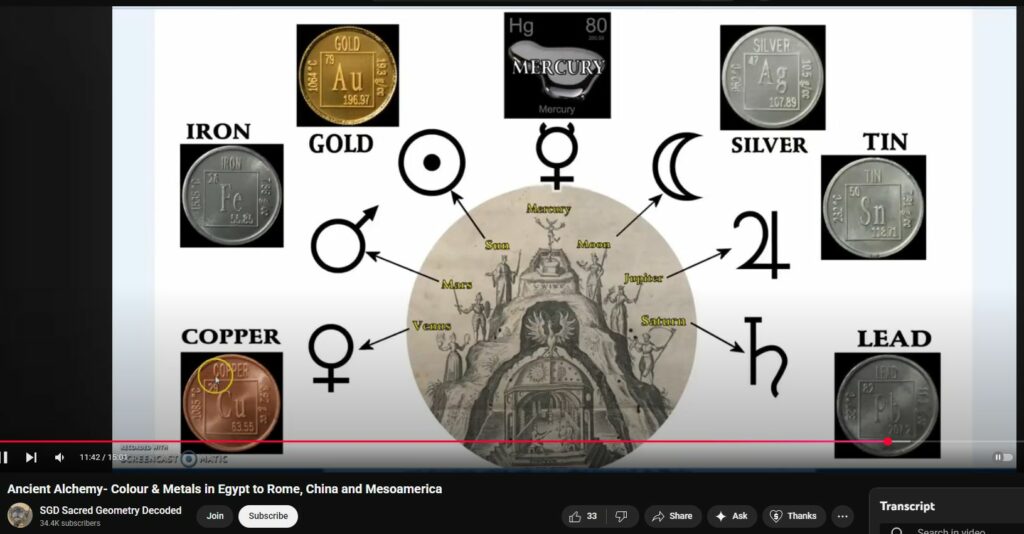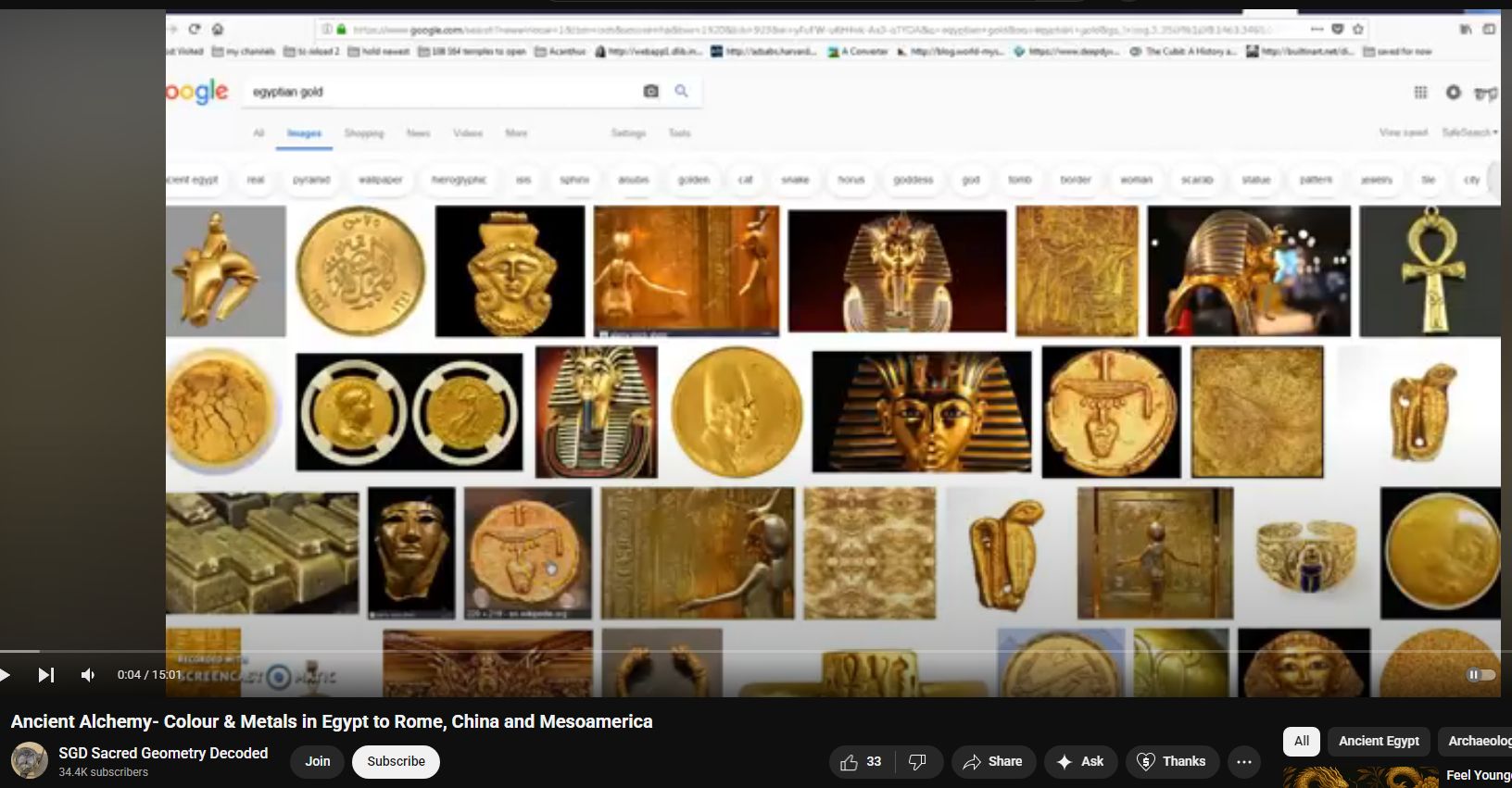Purifying ores to metals such as gold, as well as making colours for cloth and painting is the work of chemists. The ancient past was no different. The records of the Egyptian sciences are not so clear where they do remain but the heirs of this ancient knowledge such as the Greeks and Romans did leave records that are clear to read.
https://academics.triton.edu//faculty/fheitzman/Vitruvius__the_Ten_Books_on_Architecture.pdf
Transcript
Click to reveal
the k so let's have a look at Egyptian
0:03
ancient Egyptian alchemy as in alchemy
0:06
or chemistry essentially now this
0:09
alchemy has been I would say perverted
0:13
but that's a separate topic and so what
0:17
we have is how did they make this gold
0:19
had in it when you get gold out of the
0:22
ground it doesn't come out in a you know
0:23
you even when you get these pure gold
0:25
nuggets and actually not pure thought
0:27
you find disease will ancient across the
0:29
ancient world but Egyptian artifacts how
0:31
did they create this gold they had to
0:34
purify it they had to make it they had
0:36
to work of a gold man to understand to
0:38
process it very important theme now it's
0:42
often too said I want some mystery well
0:44
it's actually quite a bit of the legacy
0:47
of this knowledge carried through to
0:49
later alchemical traditions so when they
0:52
speak of alchemy it's usually 15 16th
0:54
17th century the records actually go
0:57
quite back back through to the Arabians
1:00
back fruit well back Mesopotamians back
1:03
to such as Cleopatra of Egypt
1:06
sorry Cleopatra tied a movie alchemists
1:09
not to be confused with Cleopatra at San
1:12
Anthony and Cleopatra but so how did
1:14
they create this goal 12 I had
1:16
metallurgy essentially if I had
1:17
chemistry what we would alchemy the
1:20
source is now another key theme so
1:23
alchemy is not just about metallurgy
1:25
it's not just about medicine it's also
1:27
has a lot to do with colors and so where
1:29
you see these cave / cave paintings
1:31
sorry tomb paintings other paintings the
1:34
color palette that they had and color
1:37
has been a very important theme so royal
1:39
purple
1:40
for instance the Phoenicians who
1:43
basically got rich because they had
1:45
almost a monopoly on purple sacre bleu
1:48
sacred blue so even in the early early
1:54
Christian artists that the connection
1:56
between Mary and blue because blue was
1:58
very expensive now it's very hard you
2:01
can make blue you can make even purples
2:03
but they not they don't last they're not
2:06
strong colors and they don't last over
2:08
time so to make a good quality dye or a
2:10
pigment very important you don't want it
2:13
to
2:13
made away very quickly and you wanted to
2:15
to have an intense color service has
2:18
been dyes and color has actually been a
2:21
big part of the traitor of international
2:23
trade going back to ancient times and so
2:25
how did the Egyptians do this well the
2:29
Egyptians their knowledge was passed on
2:32
to other civilizations and we have great
2:36
Greek and Roman records in the Greeks
2:38
openly discuss about the fact that they
2:40
learnt from previous civilizations so
2:42
the Egyptian color palette the history
2:47
of color and dyes pigments very
2:48
interesting because it has applies to
2:50
glassmaking and to all sorts of themes
2:52
now so how did they get these colors
2:55
well once more we can look back to the
2:58
sources and so book seven chapter seven
3:01
Vitruvius and natural colors and so he
3:04
talks as four colors summer natural
3:06
products found in fixed places and dug
3:08
up here while others are artificial
3:10
compounds on different substances
3:12
treated and mixed in proper proportions
3:14
so as to be equally serviceable they're
3:17
making color this is chemistry this is
3:20
you know industrial chemists are still
3:22
working on cut they're still inventing
3:24
new colors all the time and how to
3:25
create these pigments very important
3:28
theme so red earth now what I want to
3:33
get to is okay so let's look this is a
3:35
typical our chemical chart where we have
3:38
Venus Aphrodite Mars Aries Sun Apollo
3:41
mercury Hermes Moon Luna Jupiter Zeus
3:45
Saturn Kronus which are connected to
3:47
these very important elements over seven
3:50
visible planets these important guides
3:52
and also to the elements being used and
3:55
accessible back at the time so even
3:57
before the Iron Age strictly speaking
3:59
Oliver able to obtain bog iron and
4:01
mediate meteoric iron fur from meteors
4:04
so but before the Iron Age they were
4:07
working with iron and it did have access
4:10
to it I just didn't have access to it on
4:12
an industrial scale but most of these
4:14
metals silver gold tin silver lead
4:16
copper well how did they extract these
4:18
things so well let's begin with mercury
4:21
or Hermes of all folks
4:24
the god of knowledge now weights and
4:26
measures for
4:27
especially the element mercury and how
4:29
it connects especially to things such as
4:31
gold and silver the importance of this
4:33
element now it comes from the ore
4:35
cinnabar which is red Vermillion but
4:39
it's also so in China other ancient
4:41
cultures they were working with cinnabar
4:43
lead our sorry
4:44
mercury Quicksilver and so for instance
4:47
vermilion ink was reserved only for the
4:50
Empress was a very just like Jade
4:52
Emperor was reserved for you know the
4:55
ancient Chinese terms have been found
4:57
where they found smashed Jade priceless
4:59
Jade all over because the the tomb
5:03
robbers didn't take the Jay because they
5:05
were unable to sell it so very Ovie's
5:07
connect now mercury we extract it from
5:10
cinnabar mercury we find our mercury
5:13
pools in pyramids in South America in
5:15
Egypt and why is mercury so important
5:18
especially in liquid mercury why go into
5:21
that because again it's a anyway well it
5:24
has very practical purpose in the
5:26
production of silver and gold especially
5:27
and to create good quality gold and
5:29
silver what will the Chinese what will
5:31
the ancient Mesoamericans gold and
5:33
silver amongst other elements so why is
5:37
mercury so important now I'll show you a
5:39
clip here amalgam so okay why would we
5:43
leave it now mercury amalgam is used in
5:47
two fillings but for instance when
5:49
miners to get the gold dust out of out
5:54
of a pan you can pour mercury in there
5:56
and the mercury will attach the gold and
5:59
silver will attach to the mercury and
6:01
then you can just boil off the mercury
6:02
left with pure gold now mercury as an
6:05
example of an amalgam let's look at this
6:07
gold amalgam okay so this skip a little
6:14
bit forward okay just drop some liquid
6:16
mercury on there and what happens is
6:19
that gold essentially dissolves and and
6:22
becomes part of a mercury amalgam
6:25
Navisworks for silver and others and you
6:28
just well this is how they're how do we
6:31
know that they work like this in the
6:33
ancient time all because the ancients
6:34
left us very nice descriptions of it and
6:36
it's also connects to colors as well so
6:39
Vitruvius we can
6:41
read up on these color systems how they
6:43
were now cinnabar which is mercury the
6:47
raw ore of mercury cinema or Vermillion
6:54
now cinnabar and Oak and Quicksilver and
6:57
he discusses how it's used and how to
7:00
extract it from Bayer the unique
7:06
qualities of it and also hat well
7:08
weights and measures poured it but if
7:10
Quicksilver is poured into a vessel you
7:12
can like the ability how things float on
7:15
mercury now ok for instance if the
7:17
Quicksilver is poured into a vessel and
7:19
a stone weight one hundred pounds is
7:21
laid upon it the stone swims on the
7:23
surface and cannot depress the liquid
7:25
nor break through or separate it if we
7:27
remove one hundred pound weight and put
7:29
on a scruple of gold it will not swim
7:31
but will sink to the bottom of its own
7:33
accord hence it is undeniable but the
7:35
gravity of a substance depends on the
7:37
amount of its weight not on its nature
7:39
now further you go in down in betrayal
7:41
if you can find him talking about water
7:43
displacement and in the eureka moment of
7:47
god now in the names time Archimedes
7:50
Eureka and how this connects when you
7:53
actually read these all the documents
7:55
there are quite advanced very very very
7:57
advanced not in just working and cutting
8:00
stone and lifting stone as well they
8:02
described it in in great detail in great
8:06
detail and but also so colors so now for
8:09
instance when gold for instance in Egypt
8:12
I did in as well but rich Romans would
8:14
weave gold into their garments when the
8:16
gold has been woven into a garment and
8:18
the government becomes warm worn out
8:20
with age so he's no longer respectable
8:22
to use the pieces of cloth are put into
8:24
earthen pots and burned up in a fire
8:26
that burns away the cotton or hemp
8:29
depending on what Fred veil using the
8:32
ashes have been thrown into water and
8:33
Quicksilver added via to this attracts
8:36
all the bits of gold and makes them
8:38
combine with itself or water is then
8:40
poured off and the rest is emptied into
8:41
a cloth and squeezed into the hands
8:43
whereupon the Quicksilver being a liquid
8:45
escapes back through the loose texture
8:48
of a cloth but the gold which has been
8:49
brought together by the squeezing is
8:51
found in a pure state so to recycle the
8:54
gold this is now is
8:55
the same thing we've recalled in on
8:59
electronics this is how one way that
9:02
poisonous mind you you have to be done
9:04
very carefully but the the gold and
9:06
silver and these other rare elements
9:08
will attach to it and then there are
9:10
again other descriptions of how to
9:12
separate these are elements so you might
9:14
get gold and silver it joins to the
9:17
mercury you boil off the mercury when
9:19
you're left with electrum alloy of gold
9:21
and silver and then there are other ways
9:22
of separating it from here as well but
9:24
cinnabar continued I will now return to
9:27
the preparation of a million using
9:29
cinnabar ore of mercury to create
9:32
Vermillion red ink as in the red ink
9:35
which was exclusive to the Chinese
9:37
emperors
9:38
hence it keeps its color perfectly when
9:42
applied to the polish stucco finished of
9:44
clothes apartments get in open apartment
9:46
such as Vera styles and and again just
9:49
the use of now that it goes back to the
9:53
tomb of very Queen at Palenque and the
9:55
use of this red all this keeps you know
9:57
that you can make a red for instance
9:59
another foot but it doesn't keep its
10:01
color it's a it's this brilliant
10:03
long-lasting color reds blues
10:05
now furthermore so now of the essential
10:12
elements such as copper so artificial
10:19
colors again our prison tattoos one of
10:24
the ways they do it they get a candle
10:26
and I will burn and then hold up the
10:29
flame underneath some sort of flat
10:31
surface it will collect the soot and
10:33
then you can make a tattoo ink and
10:37
that's a pretty not it the best way to
10:38
do it but that's one of the ways that
10:40
it's done in prison but I've never been
10:43
in prison mind you I just recently saw
10:45
that on a show about tattoo artists but
10:47
the official color is black so they were
10:50
different you can also get from
10:51
compounds or a different ways of
10:52
beginning it but burnt blue burnt ocher
10:55
now our methods of making blue gore
10:57
discovered in Alexandria and afterwards
11:00
the story is set up for making of it in
11:04
at Polly's has you lowly sorry the
11:07
method obtaining it from
11:09
the substances of which it has been
11:11
found to consist he strange enough sand
11:13
and the flowers of matron obeyed it
11:15
braided together so finally about the
11:17
product is like meal copper copper
11:19
sulfate that's probably if you've done
11:21
the chemistry class in high school
11:22
copper sulfate that blue powder which
11:24
you might you know using gardens as well
11:26
that's copper sulphate copper salt and
11:30
that's blue well that's you know you can
11:32
say has it describes here you can make
11:35
blue from copper as well now you
11:37
wouldn't think copper is is blue because
11:39
it's that sort of not quite Goldy what
11:43
would you call that will let the copper
11:45
II brass bronze each color but you can
11:48
make the alchemy chemistry now white LED
11:51
and so again led like in the when the
11:56
dandies like the French rules for
11:58
instance and around that are you know
11:59
around lowest know they have you seen
12:01
with that very white face and the big
12:03
puffy week
12:05
well that was led that they were using
12:07
to make it so you're gonna make a lead
12:09
weave from white brings is a good way of
12:13
making white from lead now now for
12:18
instance Galena in places such as South
12:22
America and elsewhere you find the
12:24
minerals and it's copper bismuth zinc
12:26
gold and silver but lead as well and
12:28
then you have to separate the elements
12:29
out so we were as Mesoamericans ancient
12:32
Chinese ancient Indians are came up in
12:36
Russia ancient Egyptians they did not
12:40
you couldn't go to a store and just buy
12:42
buy pure elements you had to find the
12:45
ore and then separate your alchemy
12:47
chemistry a trade secrets and bronze
12:52
copper alloys now again so Vitruvius
12:55
link will be in a description but how
12:56
did they make purple marine shellfish
12:58
sure for instance to shirt they would
12:59
use a shell the Phoenicians or
13:01
especially big royal purple still now
13:05
other kings and queens have purple as a
13:07
ceremonial color again back in all going
13:11
back in time so how did they make these
13:12
colors well the trivia is an excellent
13:15
source for this are Herodotus Strabo
13:18
these other ancient writers who actually
13:20
traveled to Egypt
13:23
mesopotamian over and spoke with the
13:25
people in there via the right the
13:27
writings are extant
13:28
they're not and it's at well it's it's
13:31
just interesting that certain
13:32
high-profile alternative history high
13:38
priests I got I have to call it seem to
13:40
get out of a way to to not include this
13:43
information while at the same time
13:44
accusing others of suppressing
13:46
information and blood in blah blah blah
13:48
gotta break that you got to break the
13:51
take the red pill from those vicars
13:54
visible gatekeepers go both ways
13:56
and I'm not in the least offending the
14:00
gatekeepers in the establishment but
14:02
there are gatekeepers in the in the
14:03
alternative and and well I can oh it's
14:08
hard to find really a kind word for them
14:10
because the more you look and the more
14:11
of I broke away and stopped just
14:13
accepting what they say is gospel and
14:15
then you realize well these people have
14:17
been at it for decades why do they not
14:19
why did not discuss these things well
14:21
because it's a problem it's not
14:23
profitable for them there is an industry
14:26
are in going into this and links in the
14:30
description Herodotus Strabo Vitruvius
14:33
plenty other writers who we can
14:37
translate and understand in our modern
14:39
sense unlike hieroglyphs and other forms
14:42
of writing where it's bit more colorful
14:43
and the phraseology is different Latin
14:47
Greek is the root of English and so we
14:50
can understand these things much more
14:52
clearly and there is just a huge amount
14:54
of information in the ancient past
14:56
technologies that is available have a
14:59
good one



Visited 1 times, 1 visit(s) today
